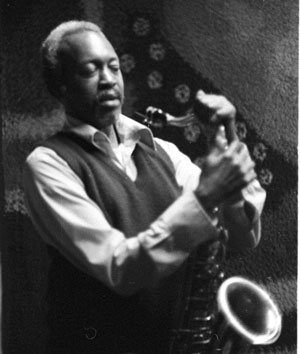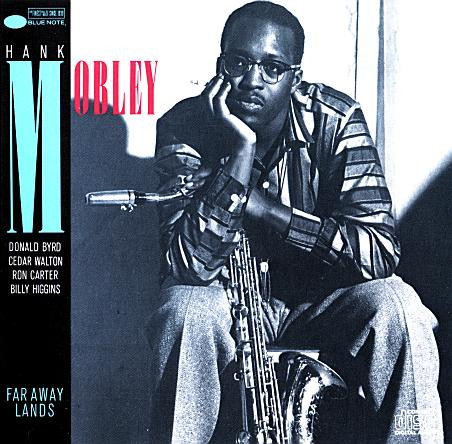Hippity Hop – Hank Mobley
A funky medium-tempo groove in that signature late '60s Blue Note style. The rhythm of the piano and bass vamp is shown in all lead sheets.
- Recording: Hank Mobley - Far Away Lands
- Recorded on: May 26, 1967
- Label: Blue Note (BST 84425)
- Concert Key: B-flat
- Vocal Range: , to
- Style: Even 8ths (funky)
- Trumpet - Donald Byrd
- Tenor Sax - Hank Mobley
- Piano - Cedar Walton
- Bass - Ron Carter
- Drums - Billy Higgins
Video
- Description
- Historical Notes
- Solos
- Piano Corner
- Bass Corner
- Drum Corner
- Guitar Corner
- Inside & Beyond
- Minus You
Though a bit faster than some other songs with a similar rhythmic feel, The Hippity Hop is a great example of the medium funky even 8ths groove that is an essential part of the late '60s Blue Note sound. The rhythm section repeats a two-measure vamp through the A sections, which is set up in an eight-measure intro; the rhythm of this vamp, which is played by both piano and bass, is shown in all lead sheets with the top note of the piano voicing. The bridge has a slightly different rhythmic pattern in the bass.
The opening melody phrase, a one-measure pickup, is built from an unusual scale: harmonic major, with a flat 6th (G♭) and major 7th (A♮). The G♭ really comes from an A♭7 chord, as the A section changes alternate two measures each of B♭7 and A♭7. In the bridge, the chord motion is stepwise from G♭7 up to B♭7 and back down to F7.
On the recording the horns play in octaves, except on the last two measures of the bridge where they harmonize tritones, alternating the root and flat 5th of F7. These harmonies are shown in all lead sheets instead of having first and second parts.
The pickup to the melody is a full measure long, but we put the D.S. on the last measure of the melody, instead of one measure earlier, to make the form clear for the solos. This pickup is played in the last measure of the last solo chorus.
The opening melody phrase, a one-measure pickup, is built from an unusual scale: harmonic major, with a flat 6th (G♭) and major 7th (A♮). The G♭ really comes from an A♭7 chord, as the A section changes alternate two measures each of B♭7 and A♭7. In the bridge, the chord motion is stepwise from G♭7 up to B♭7 and back down to F7.
On the recording the horns play in octaves, except on the last two measures of the bridge where they harmonize tritones, alternating the root and flat 5th of F7. These harmonies are shown in all lead sheets instead of having first and second parts.
The pickup to the melody is a full measure long, but we put the D.S. on the last measure of the melody, instead of one measure earlier, to make the form clear for the solos. This pickup is played in the last measure of the last solo chorus.
Most of Hank Mobley's 11 Blue Note sessions between 1965 and 1970 include at least one song with a medium-tempo funky groove. For more of these check out The Turnaround,, Give Me That Feelin', High Voltage, and The Flip; even more are coming soon to jazzleadsheets.com.
Earlier in May 1967, Donald Byrd recorded "Slow Drag," a quintet album also featuring Cedar Walton and Billy Higgins with alto saxophonist Sonny Red and bassist Walter Booker. The rhythm section of Walton, Booker and Higgins had recorded together twice earlier in 1967: in January on Byrd's "Blackjack" (same lineup as "Slow Drag" plus Mobley) and in February on Mobley's own "Third Season."
Earlier in May 1967, Donald Byrd recorded "Slow Drag," a quintet album also featuring Cedar Walton and Billy Higgins with alto saxophonist Sonny Red and bassist Walter Booker. The rhythm section of Walton, Booker and Higgins had recorded together twice earlier in 1967: in January on Byrd's "Blackjack" (same lineup as "Slow Drag" plus Mobley) and in February on Mobley's own "Third Season."
Related Songs
Email Send Hippity Hop to a friend
Send this page to a friend via email. Add your name or email in the first field. In the second, add one or more email addresses, separated by a comma.

Hank Mobley
July 7, 1930 – May 30, 1986
Hank Mobley is one of the most acclaimed tenor saxophonists in modern jazz history. He is recognized by musicians and critics alike as one of the most important and eloquent jazz instrumentalists of all time. He recorded well over 100 of his own original compositions and left an indelible mark on the post-bop jazz scene. Read more...
There was a problem.
...

